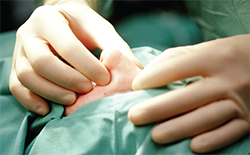
Image Credit: Phanie/Science Source
A panel of experts in rhinoplasty gathered to offer their thoughts on how they approach revision cases and to give guidance on avoiding legal pitfalls during the Triological Society session “Revision Rhinoplasty: Trends, Technology, Avoiding Litigation.”
Moderator Brian Wong, MD, PhD, professor and director of facial plastic surgery at the University of California, Irvine, said several trends have emerged over the past five to 10 years in rhinoplasty, including an emphasis on structure and flow in both function and aesthetics and, in some cases, a shift in aesthetic standards.
Technology has vastly improved since his time as a resident, he said, when using rib cartilage was an “extreme measure”; now the practice is performed routinely with fine incisions. Additionally, navigation and instrumentation have made for more precise procedures.
Case 1: Internal Valve Collapse and Nasal Obstruction
Tom Wang, MD, director of facial plastic and reconstructive surgery at Oregon Health and Science University in Portland, discussed his management of a healthy, 30-year-old woman who had had two prior rhinoplasty surgeries. She sought improvement in appearance and suffered internal valve collapse and elements of nasal obstruction.
After her first surgery, he said, she looked fine for three or four years, and then her nose started to torque. The original surgeon did work to straighten it, but no procedure was ever completely successful. The patient let it go for 10 years, but eventually the nose retwisted.
Dr. Wang noticed that the top half of the patient’s nose was quite wide, and the width pinched at the nasal tip. Additionally, she had trouble breathing out of her nose, suggesting a loss of structural support and rigidity. Dr. Wang tried to balance out the bony dorsum with the cartilaginous dorsum by rasping the dorsum and by using osteotomies to narrow the bony section, shaving down the bony dorsum for a better match.
Because the patient’s nose had a bit of additional height on the right side, he used an autospreader graft—“that is, when you release the upper-lateral cartilages, instead of trimming away the excess, you preserve that and you roll it in as an autospreader graft on the right side.”
He also used the tongue-in-groove technique to shorten the nose, which was somewhat long. But the tip had to match the reduction, and it was excessively projected, so he reduced the domes, using an incision that allowed the lateral crura to move downward to decrease alar flare.
For her internal nasal valve collapse, Dr. Wang felt a spreader graft would be insufficient and he utilized a butterfly graft. “The butterfly graft has a fairly high learning curve, but once you’ve mastered that, it tends to work very well,” he added. “I rarely now, with the butterfly graft, need to use lateral crural strut grafts.”
In the end, he was pleased with the result. “We were able to get better alignment by doing these maneuvers to establish the brow-tip aesthetic line,” he said.
Case 2: Nasal Obstruction and Three Prior Surgeries
Robin Lindsay, MD, a facial plastic and reconstructive surgeon at Massachusetts Eye and Ear Infirmary in Boston, discussed her approach to care for a 56-year-old woman with nasal obstruction and three previous rhinoplasties. Septal, conchal, and rib grafts had been used in the past, but the previous operative reports weren’t available.
“Her No. 1 priority is that she was unable to breathe through her nose,” Dr. Lindsay said. “However, she was very upset by the appearance of her nose.” Dr. Lindsay had seen photos taken before the first procedure, and the nose had been aesthetically pleasing then.
“In managing expectations, I discuss with patients that this isn’t what you would expect after a first operation,” she said. “What we want now is for you to be able to breathe through your nose, for you to have a nose that, when you see yourself in photos, you’re pleased. When you get up in the morning and wash your face, you don’t think about your nose all the time. And I think that’s a very important discussion to have with patients who are undergoing multiple revision procedures.”
Dr. Lindsay used a rib graft in this case because she didn’t think conchal cartilage would provide enough support to rebuild the structure of the nose, and she hadn’t had a wealth of experience using cadaveric rib. Additionally, she has seen literature indicating that the reabsorption rate for cadaveric rib is as much as 30%, but solid numbers are hard to come by. “I think at this point it’s personal preference, but it would be nice to really know,” Dr. Lindsay said.
She used extended spreader grafts to straighten out the woman’s septum to restore the middle wall of the nose, a columellar strut graft to reset the tip, and lateral crural strut grafts to provide lateral wall support. When using rib grafts, she suggested, it’s important to make the grafts as thin as possible, because the ribs are structurally firm and there is no need for them to be thick.
Avoiding Litigation
Dr. Lindsay stressed that it’s important to make sure patients have realistic expectations and to follow them post-operatively. “Keeping that close contact can help” avoid potential problems, she said.
“It all comes back to communication,” advised Anthony Sclafani, MD, director of facial plastic surgery at New York Eye and Ear Infirmary. He encouraged surgeons to “embrace your complications,” so that patients keep coming back and can get the right treatment.
Thomas Collins is a freelance medical journalist based in Florida.